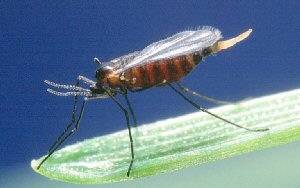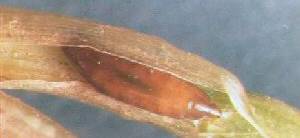Hessian Fly
 Scientific Name
Scientific Name
Mayetiola destructor
Hosts
Wheat
Symptoms
 The adult fly is tiny, fragile and mosquito-like and measures 1/8 inches. The legless
maggot-like larvae are reddish or orange when newly hatched, but become whitish-green
as they feed. When they are ready to pupate, they form a dark brown puparium, which
is called a flax seed, which are normally inserted into the crown or just above the
joint of a stem. This is normally the most common sign of Hessian fly infestations.
The adult fly is tiny, fragile and mosquito-like and measures 1/8 inches. The legless
maggot-like larvae are reddish or orange when newly hatched, but become whitish-green
as they feed. When they are ready to pupate, they form a dark brown puparium, which
is called a flax seed, which are normally inserted into the crown or just above the
joint of a stem. This is normally the most common sign of Hessian fly infestations.
Injury is caused by larval feeding on stem tissue at the crown of young plants, or just above the nodes of jointed wheat. Young plants suffer the most serious injury, as plants become stunted, and secondary tillers that are infested fail to develop. Young plants that are infested are actually a darker green to bluish-green color, and the leaves are thicker. When larvae feed on jointed stems, they become weakened and lodge. They are most likely to occur in eastern Oklahoma.
Control
Please contact your local county extension office for current information.
